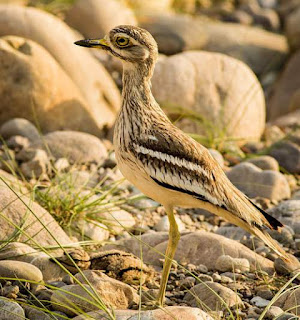Taxonomic classification <> Photos
The Indian thick-knee (Burhinus indicus) belongs to the family Burhinidae under the order Charadriiformes.
Indian thick-knee breeding behavior
The species Burhinus indicus are monogamous, forming long-term pairs. These species breed during spring and summer. Whenever possible they nest as solitary pairs. If the population is dense and the breeding habitat is restricted, more than one pair may be seen nesting in close proximity.The courtship consists of short runs, skips and leaps together with repeated wails, screams and trills. For the nest site selection, the male shows bowing display at a site and the female may scrape, shuffle and turn at the spot. The process may continue at a number of sites before selecting one.
Both the parents incubate, defend and rear the young. The typical clutch consists of two eggs. The chicks are precocial and nidifugous and have cryptic down feathers. When threatened, the chicks will crouch, drop down head and stretched out neck.
In case of minor disturbances, the parents may quietly leave the nest. If the threat is serious, the birds may resort to distraction displays and aggressive behavior. Usually, the non-incubating parent will watch for danger and warn the partner. They may attack a ground predator by diving at it.
| Taxonomic classification | |
|---|---|
| Binomial name: | Burhinus indicus |
| Species: | B. indicus |
| Genus: | Burhinus |
| Subfamily: | - |
| Family: | Burhinidae |
| Order: | Charadriiformes |
| Class: | Aves |
| Phylum: | Chordata |
| Kingdom: | Animalia |
 |
| 1.Photo of Indian thick-knee Burhinus indicus by CLpramod |
 |
| 2. Photo of Indian thick-knee Burhinus indicus by Sumeet Moghe |
 |
| 3.Photo of Indian thick-knee Burhinus indicus by Koshy Koshy |
 |
| 4.Photo of Indian thick-knee Burhinus indicus by Rahul Sheel |
 |
| 5.Indian thick-knee Burhinus indicus by Gautam Krishnan |
 |
| 6.Indian thick-knee Burhinus indicus by Tsrawal |
 |
| 7.Burhinus indicus by David Cook |
 |
| 8.Burhinus indicus by J.M.Garg |
 |
| 9.Burhinus indicus by S. Shankar |
1.Photo source: https://commons.wikimedia.org/wiki/File:Eurasian_thick-knee.jpg (cropped)
Author: CLpramod | License: CC BY-SA 4.0
2.Photo source: https://www.flickr.com/photos/ciphertux/5217589254/ (cropped)
Author: Sumeet Moghe | License: CC BY 2.0 as on 6/11/17
3.Photo source: https://commons.wikimedia.org/wiki/File:Indian_Stone-curlew_Burhinus_indicus_(4192874412).jpg (cropped)
Author: Koshy Koshy | License: CC BY 2.0 as on 6/11/17
4.Photo source: https://www.flickr.com/photos/rahulsheel/2522927417/ (cropped)
Author: Rahul Sheel | License: CC BY-NC 2.0 as on 6/11/17
5.Photo source: https://commons.wikimedia.org/wiki/File:Burhinus_indicus.JPG (cropped)
Author: Gautam Krishnan | License: CC BY-SA 4.0
6.Photo source: https://commons.wikimedia.org/wiki/File:Indian_Thick-knee_in_Koonthalulam,_India,_by_Dr_Tejinder_Singh_Rawal.jpg (cropped)
Author: Tsrawal | License: CC BY-SA 3.0
7.Photo source: https://www.flickr.com/photos/kookr/4620699899/ (cropped)
Author: David Cook | License: CC BY-NC 2.0 as on 6/11/17
8.Photo source: https://commons.wikimedia.org/wiki/File:Eurasian_Thick-knee_I_IMG_8699.jpg (cropped)
Author: J.M.Garg | License: CC BY-SA 3.0
9.Photo source: https://commons.wikimedia.org/wiki/File:Indian_Stone_Curlew.jpg (cropped)
Author: S. Shankar | License: CC BY-SA 2.5
Current topic: Indian thick-knee (Burhinus indicus) photos.